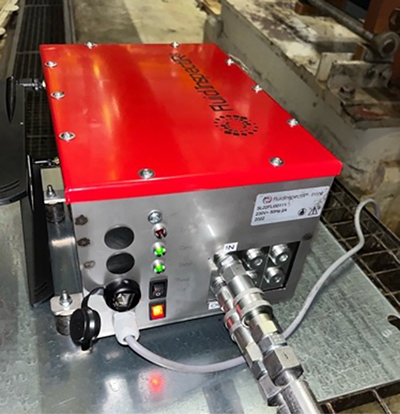Oil condition monitoring system
27/11/2023
Spectrolytic has developed a robust and affordable range of oil condition monitoring systems that give users meaningful and understandable real-time data of the same parameters and in the same units as are commonly received from oil laboratory analysis.
FluidInspectIR measures the most relevant oil degradation and contamination parameters such as oxidation, nitration, sulphation, water, soot and additives. The systems also use advanced chemometrics to extract total acid number (TAN), total base number (TBN), ipH, viscosity and other chemical changes from the data. For the in-line analyser, additional modules can be added to house a particle or wear sensor or any sensor that the user wishes to use to merge with the data stream.
The sensor platform developed by Spectrolytic utilises the powerful analytical technique of mid-infrared spectroscopy to measure a variety of relevant degradation parameters in an oil sample. With each measurement, the sensor determines the changes of the oil at a molecular level using the same analytical technique and data extraction as employed by oil laboratories around the world.
This common baseline of using mid-infrared spectroscopy as the analytical tool not only allows the sensor to provide real-time data with the same units and accuracy as the oil laboratories, but it also provides the option, by employing sophisticated mathematical algorithms, to predict more complex oil parameters such as TAN, TBN or ipH.
Spectrolytic’s FluidInspectIR Inline oil condition monitoring system allows seamless in-line installation. The kit installation is plug-and-play and can be carried out remotely with the support of the company’s Field Service Engineers.
 | ||
| Installation of Spectrolytic’s Inline Analyser at a steel plant |
The Inline Analyser can be integrated into the main oil flow of the asset via a bypass or alternatively oil can be extracted from an oil sump or oil tank using an integrated pump. If required for the application, the analyser can be configured to include particle and wear sensors, viscosity sensors or other sensors that might provide additional information.
The emitters and sensors are orientated in such a way as to avoid any undesired interference effects caused by certain microcavity effects, but at the same time to provide the best possible signal-to-noise ratio (SNR). Typically, the SNRs for these systems are 10,000:1, but it depends on the sample type and film thickness. The customer can choose the number of payload channels depending on the number of parameters that need to be measured. The MIRS8-T sensor can be used as a stand-alone device where a smaller footprint is required.
The sensors can be customised for oil type and application and easily installed, with several options for streaming data.
As we move towards the realms of Industry 4.0, it is critical that the plant asset user has access to the full data stream at the touch of a button. For the in-line system, the data can be sent to Spectrolytic’s cloud and there is an option to view/download data via a dashboard. Spectrolytic supports the customer’s cloud (Azure, AWS) via Message Queuing Telemetry Transport (MQTT) or web application programming interface (API) protocols and direct integration is available with on-site controller systems.
From the cloud web portal, the user can access the process control charts from all the sensors to obtain a complete picture of the oil condition. The user can define and set the limits for each parameter to flag any trends or step changes in the behaviour of the oil condition.